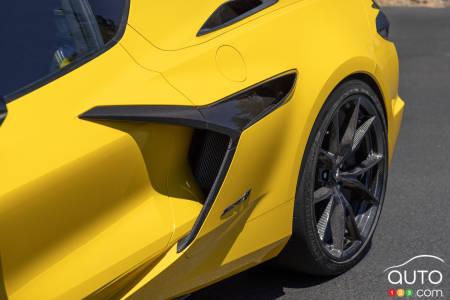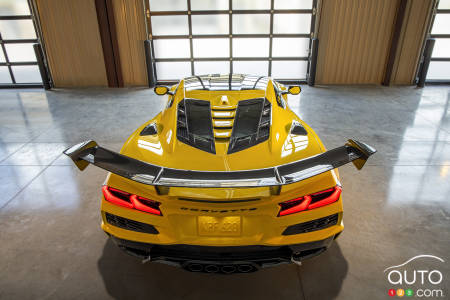• Chevrolet has unveiled the 2025 Corvette ZR1.
When the first Chevrolet Corvette was unveiled on January 30, 1953, the company was proud to announce it was powered by a 235-cubic inch (3.9L) in-line 6-cylinder engine offering 150 hp. In 1955, Chevrolet introduced its first V8 engine, capable of delivering 195 hp.
The Corvette, like the Ford Mustang, has always sought to offer more. And the tradition continues in 2025 as the company introduces the most powerful variant in the model’s history with a new ZR1 declination. Its powerful 5.5L V8 engine, aided by twin turbochargers, will be able to deliver 1,064 hp at 7,000 RPM, as well as 828 lb-ft at 6,000 RPM.


Powertrain of the 2025 Chevrolet Corvette ZR1
This engine, codenamed LT7, is an evolution of the one that appeared with the Z06 variant. We're talking about the most powerful V8 engine produced in America by any manufacturer. And this block is a benchmark in terms of technological innovation, starting with the presence of a flat-surface crankshaft.
Its capacities are virtually unlimited. It can propel the car to a top speed of 346 km/h on the track, and it can clear the quarter mile, the benchmark in drag racing, in less than 10 seconds. The body's carbon-fiber aerodynamic assembly is designed to generate 1,200 lb of downforce at high speed. It's impressive in every way.
“The team that revolutionized Corvette with a mid-engine architecture took on another challenge: take ZR1 to the next level. Corvette ZR1 is about pushing the envelope with raw power and cutting-edge innovation. From Stingray, to Z06, E-Ray, and now ZR1, the Corvette family continues to elevate with each new iteration — and challenge the best in the world.”
- Chevrolet Vice President Scott Bell


For the engineers, all that power entailed making adjustments elsewhere. Notably, the 8-speed dual-clutch automatic transmission has increased gear capacity and strength, and oil management has been adjusted to take account of the vehicle's longitudinal and lateral capabilities.
The brakes are also new and feature new technology related to the manufacture of carbon ceramic discs. The aim here is simple: greater durability and lower system component temperatures. The discs are 15.7 inches in diameter at the front and 15.4 inches (390 mm) at the rear, the largest ever fitted to a Corvette.

Design of the 2025 Chevrolet Corvette ZR1
The car's design has been tweaked, for example featuring a contoured hood for improved airflow, carbon-fibre side ducts to cool the rear brakes and unique air intakes to cool the air admitted to the turbochargers.
Chevrolet also offers a ZTK performance package that transforms the ZR1 into a real weapon on the track, with the addition of an imposing carbon-fibre rear spoiler, even more specific chassis settings and stiffer dampers, not to mention the presence of Michelin Piot Sport Cup 2-R tires.
“We went into the ZR1 program with lofty goals, but even our first development tests on-track showed the teams were already exceeding them. As we worked to develop this car, we continued to leap past expectations, and we knew we had a special Corvette on our hands.”
- Corvette executive chief engineer Tadge Juechter.


The model's design also bears a retro touch. The rear window is divided by a carbon-fibre piece that acts as the car's backbone. This increases heat dissipation from the engine compartment, but is also reminiscent of the mythical signature of the 1963 Corvette.
The ZR1 version of the 2025 Chevrolet Corvette will be assembled at the GM (General Motors) plant in Bowling Green, Kentucky. Pricing and accessibility details are still to be announced.














